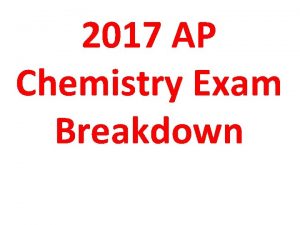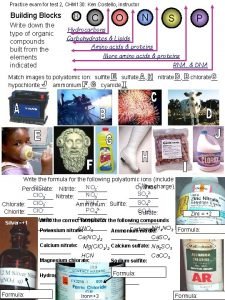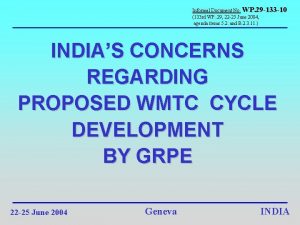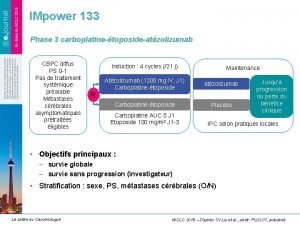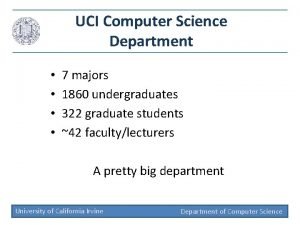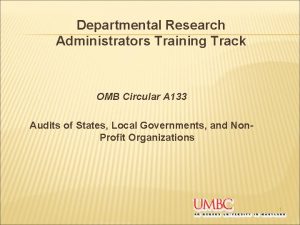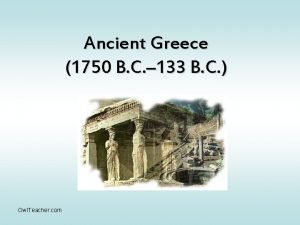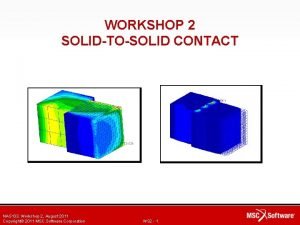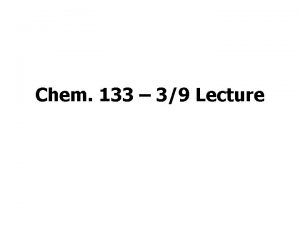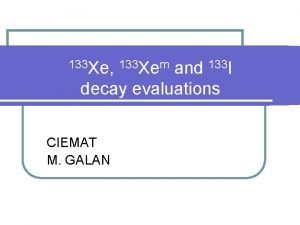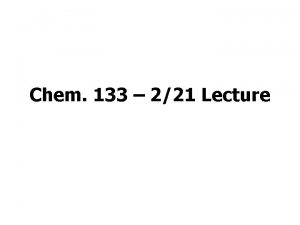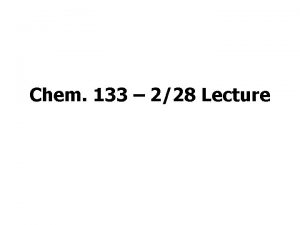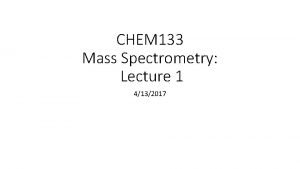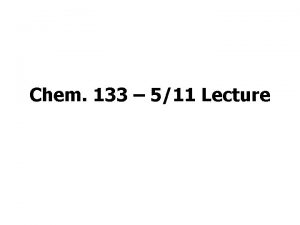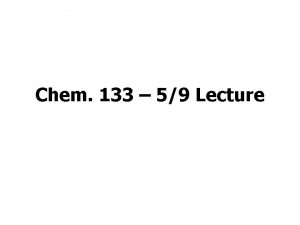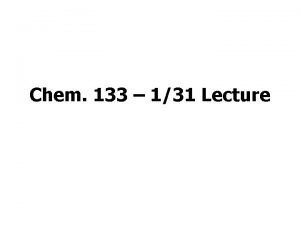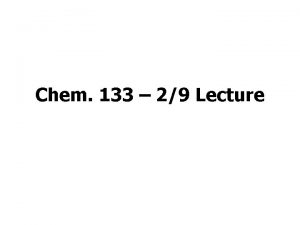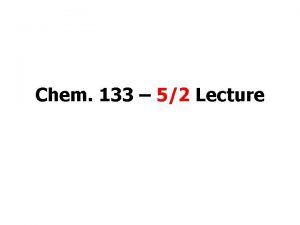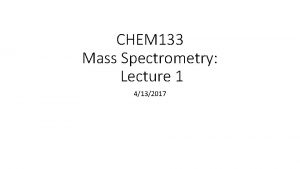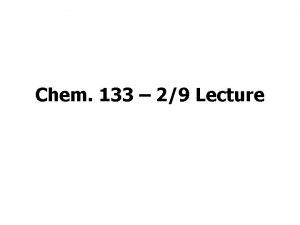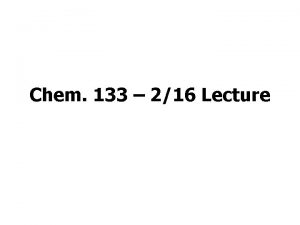Chem 133 420 Lecture Announcements I Exam 2


















- Slides: 18

Chem. 133 – 4/20 Lecture

Announcements I • Exam 2 – On Tuesday – Covering Spectroscopy Chapters (Harris 17, 19, and 20 and NMR) and Mass Spectrometry (Harris Ch. 21 – at least most of it) – Help Session on Friday 12 to 1 in Sequoia 446

Announcements II • Today’s Lecture – Mass Spectrometry • • Resolution Isotope Effects Multiple charging MS-MS and other topics if time – Review of Material on Exam 2

Mass Spectrometery High Resolution • Calculation of Exact Mass – Several compounds can have a molecular weight of 84 – Examples: • • • C 6 H 12 C 5 H 8 O C 4 H 4 O 2 C 4 H 4 S CH 2 Cl 2 – Each example above will have slightly different mass (go over mass calculations on board)

Mass Spectrometery Isotope Effects • It also may be possible to distinguish compounds based on isotopic composition • Compounds in high resolution example will have different expected M+1/M and M+2/M ratios (which will NOT require high resolution to see) • Text does not explain calculations that well • Go over calculations for CH 3 Cl, CH 2 Br. Cl, and CHCl 3

Mass Spectrometery Other Topics – Multiple Charges in ESI (M+n)/n Dm/z Ion current • In ESI analysis of large molecules, multiple charges are common due to extra (+) or missing (-) Hs (or e. g. Na+) • The number of charges can be determined by looking at distribution of big peaks • For + ions m/z = (M+1. 008 n)/n (most common) • For – ions m/z = (M– 1. 008 n)/n m/z (M+n+1)/(n+1) Example: m/z peaks =711. 2, 569. 3, 474. 8, 407. 1 I am only showing an “approximate” method for determining n and M – this usually will work when H+ is causing the charging, but not if Na+ causes charging

Mass Spectrometery Questions - #2 1. A modification is made in a peptide chain of molecular weight 1503 (native form), in which one threonine residue (NH 3 CH(CHCH 3(OH))CO 2) is replaced with cysteine (NH 3 CH(CH 2 SH)CO 2). What resolution is needed to separate the native peptide from the modified peptide? 2. Predict the M+1/M, M+2/M, M+3/M, and M+4/M ratios for the ion C 4 H 7 S 2 O 3 -.

Mass Spectrometery Other Topics - MS-MS • In LC-ESI-MS, little fragmentation occurs making determination of unknowns difficult • In LC-ESI-MS on complicated samples, peak overlap is common, with interferants with the same mass possible (e. g. PBDPs) • In both of above samples, using MS-MS is useful • This involves multiple passes through mass analyzers (either separate MSs or reinjection in ion-trap MS) and is termed MS-MS • Between travels through MS, ions are collided with reagent gas to cause fragmentation

Mass Spectrometery Interpretation Questions 1. Determine the identity of the compound giving the following distribution: m/z Abundance (% of biggest) 25 14 26 34 27 100 35 9 62 77 64 24

Mass Spectrometery Interpretation Questions – cont. 2. Determine the identity of the compound giving the following distribution: m/z Abundance (% of biggest) 29 9. 2 50 30. 5 51 84. 7 77 100 93 16 123 39

Exam 2 Topics to Know A. Chapter 17 (Spectroscopy – Theory) 1. Light defining parameters (be able to convert between l, E, n, and for light). * 2. Know processes of absorption and emission. 3. Know alternative methods of excitation and deexcitation. 4. Know regions of electromagnetic spectrum and related transitions. 5. Know basics of spectral interpretation. 6. Understand be able to use Beer’s Law equations. * 7. Know sources of deviations to Beer’s Law + region of best precision

Exam 2 Topics (cont. ) B. Chapter 19 (Spectrometers – cont. ) 1. Spectrometer Design (know main components + designs for UV, fluorescence, and FTIR spectrometers) 2. Main discrete and broad band light sources 3. Main methods of wavelength discrimination (interference filters, monochromators, polychromators, Fourier methods, and through energy dispersive detectors) 4. How interference filters work* 5. Components and calculations in grating monochromators/polychromators*

Exam 2 Topics (cont. ) B. Ch. 19 – cont. 7. Light Detectors (basic types and how they work) 8. Polychromators/Array detectors – how they work 9. How energy dispersive detectors work and what types of light measurements they are used for 10. How FTIR works + advantages and disadvantages of FTIR C. Chapter 20 (Atomic Spectroscopy) 1. Methods for Elemental Analysis (solid + liquid samples) 2. Basic theory of atomic transitions

Exam 2 Topics (cont. ) C. Chapter 20 – cont. 3. Atomization processes in flame, graphite furnace, and ICP and sources of inefficiency in atomization 4. Effect of temp. on Boltzmann distribution and on emission intensity* 5. Methods of atomization (plus advantages and disadvantages of each) 6. Types of interferences and means of dealing with them 7. How to use Standard Addition to calculate concentrations* 8. Block diagrams of AAS, AES, and ICP-MS instruments including specific components used

Exam 2 Topics (cont. ) D. NMR (R&R Ch. 11) 1. How to relate resonance frequency to magnetic field strength* 2. Types of nuclei that are NMR active and number of and spins of states based on I value of nucleus* 3. Origin of sensitivity problem and factors that affect sensitivity in NMR* 4. Causes and effects of relaxation (spin-lattice and spin-spin + relation to peak width) 5. Causes of deshielding 6. Relative position of protons in spectra due to amount of deshielding 7. Magnetic anisotropy (know electron circulation in aromatics)

Exam 2 Topics (cont. ) D. NMR – cont. 8. Relationship between ppm and Hz scales* 9. Source of splitting and predicting splitting patterns from 1 set of neighboring equivalent nuclei 10. General Proton Interpretation (# equivalent nuclei, relative # of each, relative position, # neighboring nuclei) 11. Understand magnetic field requirements 12. Understand main spectrometer components in NMR instruments (e. g. light source) E. Mass Spectrometry Topics 1. Main Instrument Components

Exam 2 Topics (cont. ) E. MS Topics – cont. 2. Methods of ionization in mass spectrometry: phase used for, ions produced, and amounts of fragmentation 3. Methods to separate ions (mass analyzers) and practical uses 4. Resolving Power* and Resolution Needs (nominal vs. high resolution) 5. Isotope effect calculations* 6. Multiple charging calculations to determine M and z* 7. MS-MS use

Exam 2: Equations Provided • • Monochromator angular and linear dispersion equations: Angular dispersion = Df/Dl = n/dcosf Linear dispersion = Dy/Dl = FDf/Dl Boltzmann Distribution Equation • Relationship between frequency and magnetic field in NMR • Portion of Pascal’s Triangle needed (for integration of splitting peaks in NMR or for probabilities in MS)
 2017 ap chemistry practice exam
2017 ap chemistry practice exam Chm 130 chapter 12 practice problems answer key
Chm 130 chapter 12 practice problems answer key David ritthaler
David ritthaler Fahrenheit 451 burning
Fahrenheit 451 burning Pvu official announcement
Pvu official announcement Kayl announcements
Kayl announcements /r/announcements
/r/announcements General announcements
General announcements 01:640:244 lecture notes - lecture 15: plat, idah, farad
01:640:244 lecture notes - lecture 15: plat, idah, farad 29/133
29/133 Impower 133
Impower 133 Una prensa elevadora de coches
Una prensa elevadora de coches Cs 151 uci
Cs 151 uci Thine is the kingdom hymn
Thine is the kingdom hymn Direct my steps
Direct my steps Omb circular a 133 audit
Omb circular a 133 audit Ancient greece 1750 b.c-133 b.c answers
Ancient greece 1750 b.c-133 b.c answers Nas133
Nas133 Nova cesta 133
Nova cesta 133
